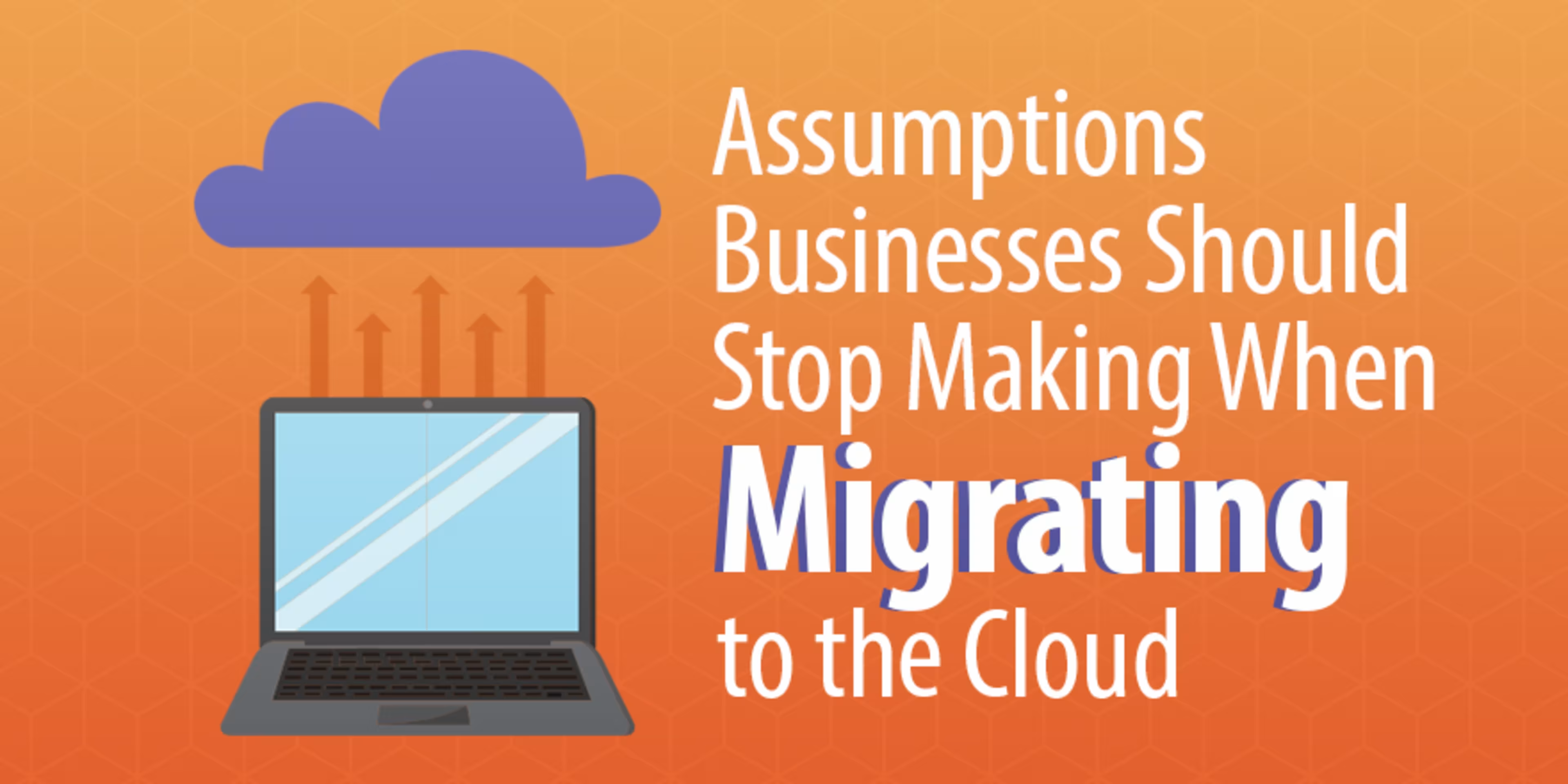The popularity of cloud services continues to rise, and for good reason. Shawn Moore (CTO at web experience software company Solodev) sums it up nicely: "The cloud enables organizations to be more nimble and Agile in their planning, pay only for what they need, and scale easily as they grow."
The promise of scale and growth is especially appealing to small businesses; original Gartner survey data shows that 59% of small businesses are already using cloud computing technology, and 22% plan to take advantage of it within the next two years.
At this point, if you haven't thought about taking advantage of cloud computing, you're in the minority.

Additional research from Gartner shows that there are a lot of misconceptions surrounding the cloud, particularly regarding the benefits offered by cloud migration (full research available to Gartner clients only). Unfortunately, these misconceptions can sometimes prompt businesses to jump on the trend of cloud computing without fully fleshing out their cloud strategies.
Without a comprehensive strategy, these businesses rely on long-held assumptions about the cloud to make the case for migration. The end result? Disappointment when the cloud fails to meet their expectations.
To help you avoid this disappointment at your business, let's break down some of the most common assumptions about migrating to the cloud and examine new ways of thinking so you can set reasonable expectations for your cloud migration experience.
Assumptions to avoid when migrating to the cloud
Assumptions about the benefits of technology are super common. So common that Gartner created the Hype Cycle to show when new tech is receiving undeserved hype (in the "peak of inflated expectations") and when people have more reasonable expectations (in the "plateau of productivity").
Cloud computing as a whole has reached the "slope of enlightenment" phase of the Hype Cycle, meaning people are catching on to what the cloud can actually do for them. Data from a recent Gartner survey backs that up, showing that 51% of small businesses now see cloud computing as critical to their business, while 41% of businesses deem the technology beneficial, even if they don't think it's necessary.
But there are still some assumptions left to dispel.
It's not that the assumptions floating around about migrating to the cloud are completely incorrect. It's that these assumptions are based on some overgeneralizations that are worth examining.
Assumption No. 1: Cloud migration will always save you money

One of the most common misconceptions is that cloud computing is always cheaper than hosting your applications yourself. This stems from the idea that migrating to the cloud frees you from the obligation to maintain and replace hardware (such as servers).
As Shawn Moore points out, "One of the biggest challenges with migration is the cost-prohibitive nature of moving applications that require significant manual oversight."
Depending on the types of applications you're migrating, the cloud could actually cost you more up front, even if it saves on operating and labor costs in the future.
A better way to look at this issue:
While cost shouldn't be your first consideration when approaching cloud migration at your company, you should always do your due diligence and research the costs of migration and cloud operation versus your current, on-premise costs.
If you're trying to pitch the whole migrating to the cloud concept to relevant decision-makers, focus on how the cloud can help you meet your overarching business goals.
Will migrating to the cloud help you better serve your customers?
Will it increase efficiency?
Will it give your IT team greater agility, allowing them to make progress on other critical projects?
Don't answer these questions with a simple "yes" or "no." Talk about how cloud migration will allow your team to work better or smarter in the long run to facilitate management buy-in.
The cloud offers a myriad of benefits that aren't directly quantifiable or even standardized across industries and businesses. Gartner research suggests forgetting about cost-saving, and instead setting your sights on "cost-transparency" (full research available to Gartner clients only). If migrating to the cloud is going to cost more, be honest about it. Then, instead of looking at the money, determine what you want from the cloud and find a way to measure those metrics—such as increased productivity or higher customer satisfaction—within your organization.
Assumption No. 2: Every application belongs on the cloud

If you're migrating to the cloud, you might think you have to go all in. Pair that with assumption number one, and you're speeding toward total migration without a brake in sight.
Take a breath. You don't have to do everything at once, and not every application will benefit from cloud service in the same way.
If you've kept Moore's commentary about certain cost-prohibitive migrations in mind, you know that you might not be able to move everything right away and remain fiscally responsible.
A better way to look at this issue:
Total cloud operation is a worthy goal, but make sure you prioritize your migration as you roll it out.
Evaluate your applications, and begin by relocating the ones that would work more effectively in a cloud environment. These are likely applications that have unpredictable or ever-changing workloads, or applications that would benefit from improved functionality through increased flexibility.
Another route is choosing the least labor-intensive applications to move as a test for how the cloud will work for your business. If the cloud doesn't work for you, you won't have sunk too much time or money into your tests.
Assumption No. 3: All your security concerns will be taken care of by your cloud provider

I'm not trying to hearken back to the fearmongering days when the cloud was considered a lawless, nebulous place that could never be as secure as your DIY methods.
Debunking this assumption is more about common sense than anything else. While the cloud can be more secure than hosting applications on-premise pending on your cloud provider's security practices, that doesn't guarantee that it's more secure than if you were hosting solutions yourself.
A better way to look at this issue:
Talk to your cloud provider about security. Ask about their security methods and strategies—preventive and reactionary—to make sure they meet your standards.
Even if your cloud provider has security that rivals Fort Knox, take steps to ensure that your applications are secure on the cloud. Think of it as double-checking to make sure your doors are locked before you go to bed at night. You might know you locked them earlier, but won't you sleep easier if you check again to make sure everything is secure?
Capterra's computer security software directory is full of solutions to help secure your apps on the cloud.
Assumption No. 4: Everyone will navigate the change seamlessly

You might think that migrating apps to the cloud is your biggest challenge and that, once you're done, everything will go back to running smoothly.
Cristian Rennella, CEO and founder of Argentinian financial services comparison site elMejorTrato.com, has some experience in how employees deal with change:
In the migration process, the most difficult aspect was the change for employees. People were used to what they had been doing for years, and innovation is not always welcome when everything is working well.
Just because migrating to the cloud is good for your business overall, doesn't mean your employees will see it as immediately beneficial as they go about their daily work. If your experience is anything like Rennella's, guiding your staff through the migration process might be your biggest challenge yet.
A better way to look at this issue:
Start by communicating the benefits of cloud migration to your employees before moving applications. Even if migrating to the cloud is frustrating in the short-term, let them know how the move will improve your business long-term and make their lives easier overall.
You can also do what Rennella did to combat adoption difficulties: use gamification. Rennella's team developed a game that rewarded employees with points and prizes based on their usage of the new cloud software. Gamification increased the rate of change from the old system to the cloud by 23.1%.
Assumption No. 5: You don't need a cloud expert on your team

I'm sure your tech team is full of talented, intelligent individuals who are used to figuring out how things work. But as Shawn Moore (Solodev CTO) points out:
Migration requires a deep understanding of the original application environment and the destination, as well as critical variables that change and augment the performance of a best-of-breed cloud configuration. [...] You need a dedicated partner to help you decipher the value of each discrete technology and what works for you.
In short: you need someone who understands the cloud to help you get the most out of it. While your engineers and developers are great at what they do, if they don't have in-depth knowledge of how the cloud works, they can't always help you make the best decisions during migration.
A better way to look at this issue:
If you're considering migrating to the cloud, start looking for an expert to help you through the process. You can hire someone to stick around and help you navigate the cloud continuously, or bring on a temporary consultant whose main concern is migrating your applications.
Moore offers the following take on skills you should look for in a cloud migration partner:
Having a partner with experience in custom scripting—the kinds of smart, complex tools that can crawl and scan applications and translate the right variables—is essential. These partners typically have pre- and post-migration strategies for testing, helping to further scan for errors, broken links, and other issues that don't map to the origin point.
Moore also points out that, in a complicated process like cloud migration, "people make the difference." Make sure you have the best people working with you to solve problems, creatively, as they come up during your cloud migration process.
Put your new cloud migration mindset to good use
According to a recent Gartner survey, 63% of businesses who have migrated to the cloud are seeing a significant impact from cloud computing, while 27% who have adopted cloud technology or are evaluating its benefits expect to see a noticeable impact within the next two years.
Cloud computing shows the most promise in allowing businesses to scale quicker with fewer technical challenges, such as outdated hardware or maintenance costs.
You can't grow effectively if you're not using the cloud to its full potential by avoiding assumptions and associated pitfalls. Now that we've debunked some of these assumptions and outlined a new mindset, your small business can take steps to realize an immediate, positive impact from cloud migration.
If you're in the middle of migrating to the cloud, what are some of the challenges you've experienced thus far? If you're done migrating, what lessons did you learn? Let me know in the comments below!
Want to learn more about an IaaS provider? Our list of the top IaaS providers and their features will help you narrow your search. Read more in Capterra’s IaaS providers hiring guide.